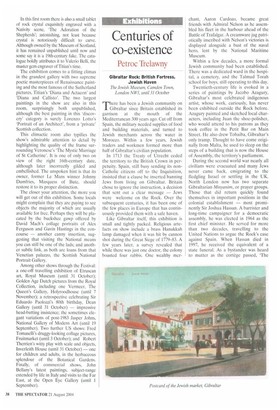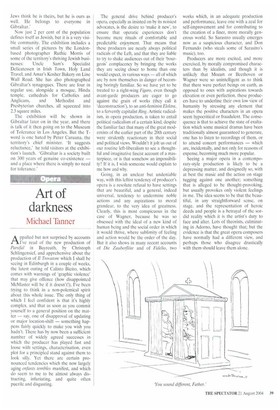Centuries of co-existence
Petroc Trelawny
Gibraltar Rock: British Fortress, Jewish Haven The Jewish Museum, Camden Town, London NW!, until 31 October
There has been a Jewish community on Gibraltar since Britain established its garrison at the mouth of the Mediterranean 300 years ago. Cut off from Spain, the military needed supplies of food and building materials, and turned to Jewish merchants across the water in Morocco. Within a few years, Jewish traders and workmen formed more than half of Gibraltar's civilian population.
In 1713 the Treaty of Utrecht ceded the territory to the British Crown in perpetuity. Spain, still busy sending its nonCatholic citizens off to the Inquisition, insisted that a clause be inserted banning Jews from living on Gibraltar. Britain chose to ignore the instruction, a decision that sent out a clear message — Jews were welcome on the Rock. Over the subsequent centuries, it has been one of the few places in Europe that has continuously provided them with a safe haven.
Like Gibraltar itself, this exhibition is small and tightly packed. Religious artefacts on show include a brass Hanukkah lamp damaged when it was hit by cannon shot during the Great Siege of 1779-83. A few years later, a survey revealed that while there was just one doctor, the colony boasted four rabbis. One wealthy mer
chant, Aaron Cardozo, became great friends with Admiral Nelson as he assembled his fleet in the harbour ahead of the Battle of Trafalgar. A crearnware jug patriotically inscribed with Nelson's victories is displayed alongside a bust of the naval hero, lent by the National Maritime Museum.
Within a few decades, a more formal Jewish community had been established. There was a dedicated ward in the hospital, a cemetery, and the Talmud Torah school for boys, still operating to this day.
Twentieth-century life is evoked in a series of paintings by Jacobo Azagury, Gibraltar's most celebrated indigenous artist, whose work, curiously, has never been exhibited outside the Rock before. Azagury painted and sketched local characters, including Juan the shoe-polisher, who would attend to his patrons as they took coffee in the Petit Bar on Main Street. He also drew Tobaiba, Gibraltar's only tramp. Thought to have come originally from Malta, he used to sleep on the steps of a building that is now the House of Assembly, the territory's parliament.
During the second world war nearly all civilians were evacuated and many Jews never came back, emigrating to the fledgling Israel or settling in the UK. North London now has two separate Gibraltarian Minyanim, or prayer groups. Those that did return quickly found themselves in important positions in the colonial establishment — most prominently Sir Joshua Hassan. A barrister and long-time campaigner for a democratic assembly, he was elected in 1964 as the first chief minister. He served for more than two decades, travelling to the United Nations to argue the Rock's case against Spain. When Hassan died in 1997, he received the equivalent of a state funeral. As a bystander was heard to mutter as the cortege passed, The Jews think he is theirs, but he is ours as well. He belongs to everyone in Gibraltar,' Now just 2 per cent of the population defines itself as Jewish, but it is a very visible community. The exhibition includes a small series of pictures by the Londonbased photographer Ruthie Morris of some of the territory's thriving Jewish busi nesses: Uncle Sam's Specialist Delicatessen in Irish Town, Holy Land Travel, and Amar's Kosher Bakery on Line Wall Road, She has also photographed Gibraltar's synagogues. There are four in regular use, alongside a mosque, Hindu temple, cathedrals for Catholics and Anglicans, and Methodist and Presbyterian churches, all squeezed into 2.3 square miles.
The exhibition will be shown in Gibraltar later on in the year, and there is talk of it then going on to the Museum of Tolerance in Los Angeles. But the Tword is one hated by Peter Caruana, the territory's chief minister. 'It suggests reluctance,' he told visitors at the exhibition's launch. 'Gibraltar is a society built on 300 years of genuine co-existence — and a place where there is simply no need for tolerance.'



























































 Previous page
Previous page